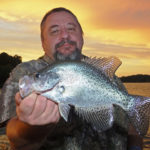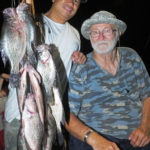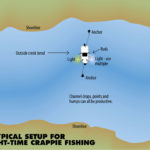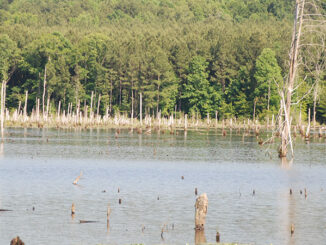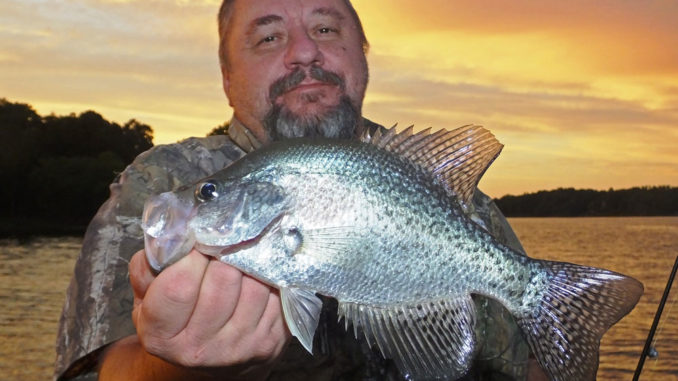
Join the ‘midnight shift’ and catch crappie after dark through the summer. Here’s how to get up to speed.
On any given late spring or summer evening, on lakes throughout the Carolinas, the “midnight shift” of crappie fishermen head for the water. They arrive as the sun starts sinking, and by dusk, they’re rigged and ready with powerful, submersible lights, plenty of bait and multiple crappie rigs to attract and catch crappies.
This faction of hard-core, nocturnal crappie fishermen generally refer to themselves as “nightstalkers.” Among the best, and certainly one of the most experienced, is Robert “Rango” Plemmons from Rock Hill, S.C.
Plemmons has honed his crappie fishing for a half-century, over the past 48 years focused primarily on nighttime fishing for crappie using lights. Much of his fishing is on his home lake, Lake Wylie. This lake is on the border between North Carolina and South Carolina, but he’s fished many lakes throughout the Carolinas. And his method has proven productive everywhere he’s fished.
“I’ve fished all over the Carolinas and beyond,” Plemmons said. “Nightstalking is the name we’ve taken, because we simply enjoy fishing at night. We’ve even held tournaments between North Carolina and South Carolina anglers, as well as competing with nightstalking teams from Georgia.”
Plemmons, 70, said his passion for nightstalking came from his love for catching crappie and the serenity of the nighttime hours. He also enjoys the opportunity to fish with others who share the same fishing passion.
Nightstalkers are a passionate breed of anglers
In 2004, Plemmons began fishing with O.T. Phonephet of Gastonia, N.C.. They’ve developed a crappie-catching partnership bordering on legendary. Rodger Taylor, a catfish guide on Lake Wylie, said when local anglers discovered where Plemmons and Phonephet were launching their boat on any given evening, word would spread. And many would gather and wait at the landing until they returned — just to see the fish caught.
Plemmons and Phonephet are passionate about nighttime fishing and have boats rigged exclusively for it. Plemmons said successful fishing for crappie after dark is an art form. It is never based on random, haphazard fishing techniques.
“Plenty of preparation is required before fish-catching time,” Plemmons said. “Going out and randomly dropping an anchor and setting out lights is not a recipe for success. Boat position, depth and bait presentation are just as crucial at night as by day.”
Plemmons said when he began crappie-fishing in 1968, he fished daytime hours for a couple of years and learned to target channel ledges, points, humps and other unique underwater features.
“When I got hooked on night-fishing, I discovered those same unique areas are crucial to night-fishing success,” he said. “Fishing where crappie already congregate is essential, whether you fish by day or night.”
Electronics, boat positioning are keys to success
Plemmons and Phonephet prefer to fish over deep water, targeting the base of a channel ledge, point or mid-lake intersection of a secondary channel with the main channel. They check their depth finder for indications of forage as well as crappie. And their boat is anchored where they can fish the bottom of the drop, as well as part of the slope.
“I want the boat to be anchored where we can fish water at least 20 feet deep, and often as deep as 30 feet, on Lake Wylie,” Phonephet said. “Best depths may change some from one lake to another. But crappie are usually caught well off the bottom in the water column. Many fishermen fish too deep. We catch lots of crappie as shallow as 10 feet or often much shallower. That’s why anchoring over deep water works. The fish simply adjust to the depth in the water column they prefer. By fishing different depths, we can sort that out, but it’s crucial to have deep water under the boat.”
Phonephet and Plemmons prefer very bright, underwater LED lights because the bright light will attract crappie from a long distance. Plus, LEDs have a much-lower battery drain than other lights they have used in the past.
The light draws fish in
“We’ve got to be in an area where crappies are already located, but even if they’re scattered, we can draw them in,” he said.
Plemmons said one factor crucial to success is getting a really good anchor set.
“I want to be anchored well before dark, and we’ll take our time to get the anchors locked in to ensure the boat is exactly where we want it and our anchor set will hold,” he said. “We prefer anchors that dig into the bottom for maximum holding power. So boats passing with a large wake or a wind shift won’t mess up boat position.
“On a perfect evening, I’ll actually be fishing 45 minutes before dark, and we’ll usually catch a few fish before dark.”
Light placement is also crucial
Another nocturnal crappie fisherman from the Lake Wylie area is Roddy Beard, who said light placement around the boat is also crucial.
“Don’t drop the lights deep into the water. We’ve found they attract fish better when lowered about a foot or less below the surface,” he said. “We’ll have a light at each fishing station and have four or more rod holders for each fisherman. If fishing action is hot, that’s plenty to watch. But we adjust the number of rigs based on the number of people fishing. Experienced nightstalkers can effectively handle more rigs.”
Mac McCarpley, another nightstalker from York, S.C., said the action is not restricted to just the targeted species, crappie.
“On any given night, we’ll catch mostly crappie, but also lots of white perch, catfish and largemouth bass,” he said. “I target crappie, but with the other species also biting, the action is usually steady to fast-paced. Small white perch can be bothersome, but the larger perch are excellent-eating fish and keep me focused on watching rod tips. That means I’ll see more crappie bites.”
Keep things simple when it comes to tackle
Plemmons has experimented with many types of rigs and terminal tackle, and the best rigs are relatively simple ones.
“I’ll use light line, usually 8-pound test, but less is OK,” he said. “I rig a No. 2, gold Eagle Claw wire hook and use a No. 2 split shot about 10 inches above the hook. I vary the length of the rods, because that enables me to fish different areas of the lighted water. Sometimes crappie will get directly under the light. Other nights, they hold close to the edge of the light field, usually several feet out.”
Plemmons uses spinning outfits from 4 ½ to 9 feet, all ultralight to detect subtle bites. This enables him to effectively fish near the light as well as near the edge of the light beam. He alternates the long and short rods and he keeps a few spares of each in case a definitive pattern develops. Any length of rod can produce crappie, but often one length is more productive on a given night. But it can change the next trip.
“We vary the depths fished until we find a pattern,” he said. “We’ll have rigs fishing from 3 feet deep to near the bottom to begin. As a pattern develops, we target that depth, but I keep a few at other depths because patterns change. Fishing deeper usually results in more perch and catfish hookups. Depth fished at night is as crucial as daytime, and it’s often a moving target.”
Simple modification makes detecting bites easier
Plemmons said another crucial factor is to paint the tips of his rods with a flat, white paint for better visibility.
“Of all the tinkering I’ve done over the years, painting the tips flat white is one of the best things I’ve done,” he said. “Ultralight tip rods with the tips painted white enable me to see the subtle bite much better. I also now use a LED light positioned high and in the back of the boat to light up the entire fishing area much better than in the past. But that white tip on the rod adds fish to the cooler.”
Phonephet and Plemmons typically fish until about 1 a.m.
“Sometimes the bite will be good all night, and we used to do that a lot. But we’ve found that after one o’clock in the morning the bite often slows until just before dawn,” he said. “For those who stay all night, the hour before dawn and for a while just after dawn, the fishing can be really good. But on a productive night, we’ll be done between midnight and 1.”
Plemmons said anglers may need a bit of patience when it comes to learning how to fish at night.
“When fishing a lake for the first time, I’ll adhere to strategies learned during the years. And we’ll typically catch fish. Often, we’ll do really well,” he said. “But sometimes it takes multiple trips to begin to fine-tune the quirks of a particular lake. Once I find a really productive spot, the underwater features that make it productive usually make it consistently reliable.”
Nightstalking is about more than catching fish
Plemmons said the love of nocturnal fishing is not just catching fish.
“Of course, catching lots of fish is the goal. But being on the lake after dark when recreational traffic is less and the air is cooler makes fishing enjoyable,” he said. “Sharing this fishing with friends and family — where we can talk, joke and have a good time while catching lots of fish — is a big attraction to this type of fishing.”
Click here to try a slightly different twist to fried crappie.

